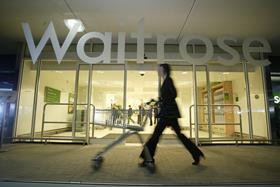
Cost price increases have started to bite at Waitrose in a further sign of the growing pressure across retail supply chains.
John Lewis Partnership (JLP) announced that operating profit before exceptionals had plummeted 17.4 per cent at Waitrose in the six months to 29 July. It said this was down to 'lower margin due to higher cost prices, very few of which were passed on to our customers', though it added that this was offset by strong cost control and productivity improvements.
That tightening of the reins included head office costs down 2.4 per cent on last year, and items sold per hour in shops up 1.6 per cent. The rollout of a flexible working programme was also credited with improving productivity, with staff able to work across the entire shop depending on customer needs.
Like-for-like sales at the supermarket rose 0.7 per cent, with gross sales up 2.3 per cent to £3.3 billion over the period.
The group said it is on track to achieve a range of improvements in 130 branches, with 68 having received investment in the first half of the year. A further 62 are due to receive upgrades in the second half.
Other areas of investment have included the appointment of a director of food service as it looks to develop its capabilities in that area, as well as an improved website.
JLP group chairman Sir Charlie Mayfield said: 'As we anticipated in our full year results statement in March, the first half of this year has seen inflationary pressures driven by exchange rates and political uncertainty. These have dampened customer demand, especially in categories connected to the housing market. Against that backdrop, our market sharegains in Fashion stood out. The exchange rate driven increase in cost prices has also put pressure on margin. We have chosen to hold back on increasing prices across many areas.
'Our results also reflect the acceleration of our strategy to ensure the Partnership's success in the future. This has included: changing the way we operate Waitrose branches, creating new flexible team structures with broader responsibilities; further changes in John Lewis to adapt the business for the future; and moving from divisional to Partnership functions across Finance, Personnel and IT.'






No comments yet